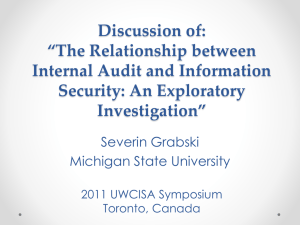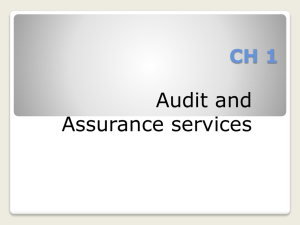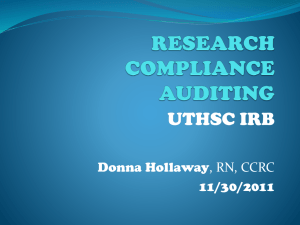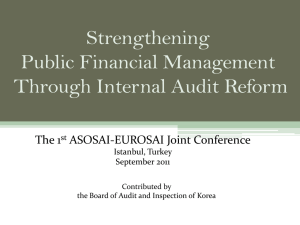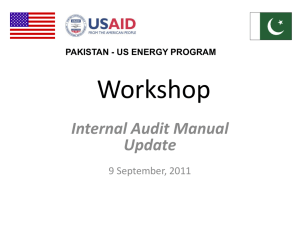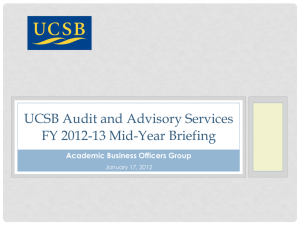Presentation
advertisement
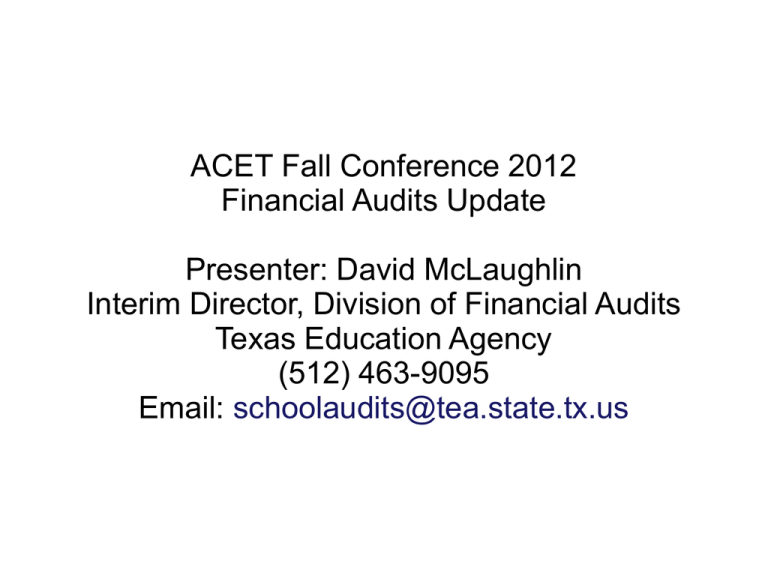
ACET Fall Conference 2012 Financial Audits Update Presenter: David McLaughlin Interim Director, Division of Financial Audits Texas Education Agency (512) 463-9095 Email: schoolaudits@tea.state.tx.us What role does TEA play in Federal Funds? TEA is required to monitor federal awards to ensure awards are used in compliance with laws, regulations, and the provisions of contracts or grant agreements and that performance goals are achieved. Supplement vs. Supplant Rules Auditors will presume supplanting occurred if federal fund were used to provide services that: • Were required to be made available under other federal, state, or local laws. • The subrecipient conducted in the prior year with non-Federal funds. What documents will auditors review? Purchase orders Payment authorization forms Payroll authorization forms Travel reimbursement forms Employee reimbursement forms What documents will auditors review? Journal vouchers Cost allocation plans and working papers Budget working papers Original third-party itemized invoices/receipts Contracts, including amendments What documents will auditors review? Bank statements Grant Application and amendments Inventory of assets and equipment purchased Bidding records for purchases Common Findings in TEA Federal Audits Local policies and procedures did not address: Preparation, review, approval and submission of expenditure reports for federal awards The process that subrecipient personnel are required to follow for the expenditure of grant funds for travel costs Common Findings in TEA Federal Audits Local policies and procedures did not address: The process used to develop and amend the budget A specific administrative procedure requiring the filing of written correspondence with the TEA regarding the disposal of personal or real property purchased with federal funds Common Findings in TEA Federal Audits The positions paid out of grant funds did not agree with the positions approved in the budget The subrecipient failed to maintain adequate and sufficient source documentation to support the expenditures charged to the grants and reported to TEA as the basis for its reimbursement from the applicable grant program Common Findings in TEA Federal Audits The subrecipient did not maintain adequate documentation to support the payroll costs charged to the grant (time and effort documentation, extra duty pay agreements, time sheets, etc.) The subrecipient obligated grant funds outside of the grant period that was not approved as a pre-award cost in the grant application as amended Common Findings in TEA Federal Audits The expenditures charged to the grant did not align with the objectives outlined in the campus/district improvement plan Inability to reconcile time and effort records with actual payroll costs Texas Education Agency website for Division of NCLB Program Coordination: http://www.tea.state.tx.us/index4.aspx?id=4261&menu_id=798 This site includes links to a number of other pages with information about numerous Federal Programs. Purpose of State Compensatory Education SCE is defined in law as programs and/or services designed to supplement the regular education program for students identified as at risk of dropping out of school. The purpose is to increase the academic achievement and reduce the dropout rate of these students. How are Texas LEAs funded for SCE? Funding is based on the number of students reported on the free- or reduced-price lunch count from the average of the district’s best six-months’ enrollment from the previous school year or in the manner provided by commissioner’s rule, if no campus in the district participated in the national school lunch program of free or reduced-price lunches during the preceding school year (HB 2879, 77th Legislature) Common Findings in TEA SCE Audits Lack of documentation No evaluation of SCE program At risk students incorrectly identified Lack of supporting documentation in CIPs/DIPs Funding of State Mandated rules, programs, or positions Lack of policies and procedures outlining the SCE program Texas Education Agency website for SCE: http://www.tea.state.tx.us/index4.aspx?id=4082 The frequently asked questions is continually updated with the most recent questions/answers Perception is everything “Flags” in an auditor's world Auditors are trained to identify “flags” “Flags” tell an auditor that something unexpected was found. Every “flag” expands the time spent on an audit and can potentially expand the scope of an audit. When auditors see a number of “flags”, they tend to lose faith in the LEA's financial and other data. Top Twelve Ways to Raise an Audit “Flag” Top Twelve Ways to Raise an Audit “Flag” 1. Throw away receipts. Auditors love to see original receipts when possible, because they represent third party confirmation of a purchase. By not keeping these receipts with the Purchase Order and other financial records, you raise a “flag”. Top Twelve Ways to Raise an Audit “Flag” 2. Never use Purchase Orders. Auditors love to see Purchase Orders because they help document purchasing approvals of the LEA. Auditors love purchase orders even more when they are dated prior to the actual purchases. By not using Purchase Orders, the auditors will now question other portions of the approval process of the LEA, and will see a “flag” raised. Top Twelve Ways to Raise an Audit “Flag” 3. Purchase personal items with school district money. One aspect of auditing financial transactions is making sure the expenditures were legally allowable. A Texas ISD once spent a large amount of money to decorate the top of their baseball dugouts with tile. Later, it was discovered that the same tile showed up on the Superintendent's house, and was installed by District maintenance workers during school hours. Top Twelve Ways to Raise an Audit “Flag” 4. Spend money on items that are specifically not allowed in your Notice of Grant Award (NOGA). Another aspect of an audit is comparing actual expenditures to the allowable types of expenditures. Anything that violates these allowable expenditures will raise a “flag”. Top Twelve Ways to Raise an Audit “Flag” 5. Charge everything to local funds, and then when those run out, start charging costs to Federal programs. A Texas district had several Principals that charged everything to their local funds, and then when those funds ran out in March, they started charging Federal grants for supplies. This raised a “flag” and auditors challenged the LEA to prove that the costs charged to the federal program were appropriate. Top Twelve Ways to Raise an Audit “Flag” 6. Use the same Campus Improvement Plan (CIP) and District Improvement Plan (DIP) each year. If your LEA had areas needing improvement, doing the same things each year would likely achieve the same results. Auditors will compare your CIP and DIP to the expenditures to make sure you spent money the way you planned to spend money to help your students. Repeating CIPs and DIPs can represent a “flag”. Top Twelve Ways to Raise an Audit “Flag” 7. Take capital assets purchased with Federal money home for personal use. A Superintendent once took an old school bus to his deer lease and converted it into a deer blind. When auditors inquired, he took the auditors to the bus (which still had the tax exempt license plate on the back end). This was a very large “flag”. Top Twelve Ways to Raise an Audit “Flag” 8. Use Federal Plans to replace funds that were spent locally in prior years (Supplanting). A Texas LEA started a drug testing program for their students. After three years, they were awarded a federal grant for drug testing. Instead of adding another layer to the local drug testing program, the LEA stopped using local funds and operated their drug testing program with the Federal grant money. This is Supplanting, and a “flag”. Top Twelve Ways to Raise an Audit “Flag” 9. Spend an enormous amount of money for food and charge it to a federal program. A Texas LEA went from spending about $1,000 annually for food for administrative meetings to spending over $45,000 annually for meals for administrative meetings. This was a “flag” for the auditors, but the LEA also charged $15,000 of these meals to federal programs where meals were not an allowable expenditure. This earned the LEA two “flags”. Top Twelve Ways to Raise an Audit “Flag” 10. Charge travel costs for a Board retreat to a federal program that did not allow this as an expenditure. A Texas LEA had their School Board attend a National Convention in Las Vegas, and charged this to a federal program (“flag” 1). The LEA had a Board policy that forbid travel outside of Texas (“flag” 2). The LEA compounded this by paying for Board Member spouses (“flag” 3). The LEA then earned a fourth “flag” when auditors realized that the Board traveled to Las Vegas the week after the National Convention. Top Twelve Ways to Raise an Audit “Flag” 11. Put your auditors in a basement with no air conditioning in 107 degree weather. Top Twelve Ways to Raise an Audit “Flag” 12. File required reports consistently late. Another step that auditors perform is to check for compliance. One of those checks involves insuring that the LEA files their reports on time and accurately. Each compliance violation represents another “flag” to the auditor. Top Ten Ways to Shorten an Audit Top Ten Ways to Shorten an Audit 1. Organize your documents prior to the arrival of the auditors. An LEA that is constantly “searching” for documentation during the audit can trigger a “flag”. But being prepared and able to produce documentation quickly for the auditor will shorten the audit as the auditor has more faith in your LEA. Top Ten Ways to Shorten an Audit 2. Make sure your documents have a logical “flow”. Auditors love to see an organized process where an LEA identifies needs, plans processes to address those needs, and assigns appropriate resources to attain the goal. Top Ten Ways to Shorten an Audit 3. Understand your financial system. Make sure that you know the capabilities and limitations of your financial software. You may be asked to provide additional information to the auditors, and the quicker you are able to produce this documentation, the faster your audit will get completed. Top Ten Ways to Shorten an Audit 4. Know where all of your supporting documentation is located. Plan ahead to try to anticipate documents that the auditors may ask for. Start by reviewing your NOGA, and then follow the flow in the NOGA where it discusses reporting requirements (fiscal and program). Top Ten Ways to Shorten an Audit 5. Make sure your time and effort documentation matches the expenditures in your federal grants. Your time and effort documentation should drive the costs charged in payroll to your federal grant. It is critical that all departments communicate any change in duties for personnel that are charged to federal programs, in order to adjust the payroll (if necessary). Top Ten Ways to Shorten an Audit 6. Demonstrate that you know Supplement vs. Supplant. Your auditor will be looking for Supplant issues when they test expenditures. Make sure that your costs are supplemental and do not replace State or local funds that were used in prior years. If you are able to demonstrate to the auditor that you routinely check for this compliance, you should have a shorter audit. Top Ten Ways to Shorten an Audit 7. Make sure that everyone in your LEA understands the process and pieces. Your auditors may question staff at all levels to see if they understand how the program works, what is allowable, what is required, etc. If you communicate this information to all of your staff involved with that program, then the auditors will be less likely to add additional audit tests, which will shorten your audit. Top Ten Ways to Shorten an Audit 8. Make sure you amend your federal grant budget on your LEA books when you amend your Federal Grant with TEA. Auditors will perform tests to insure that your LEA federal program budgets match the budgets that TEA has approved for that program. By insuring that these match, you will shorten your audit. Top Ten Ways to Shorten an Audit 9. Make sure your Board Policies match your actions. Auditors will perform tests to insure that your federal expenditures not only meet Federal law, but they will also insure that these expenditures do not violate your School Board Policy. If you have a practice that violates Board Policy, you need to change Board Policy or change your process. Top Ten Ways to Shorten an Audit 10. Make sure your activities match the allowable expenditures in your NOGA. Auditors will perform tests to insure that your federal expenditures are allowable costs according to your NOGA. This should be an ongoing step in your budget process. Questions to ask yourself when looking at a possible expenditure 1. Does this break a Federal law? 2. Does this violate a Federal grant rule? 3. Does this violate a State law? 4. Does this violate a School Board Policy? 5. Is there a local precedence for this expenditure? 6. Is this the best use of funds for students? Specific questions should be directed to: schoolaudits@tea.state.tx.us TEA Division of Financial Audits mailbox

